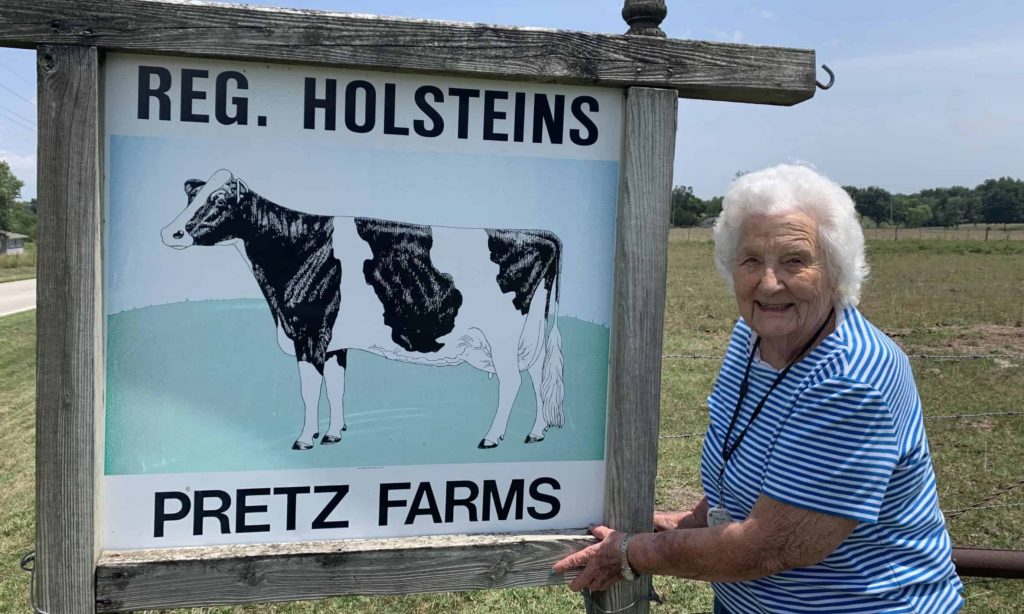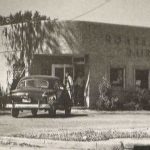
Bertie Dinkle smiled from her seat at the Louisburg Senior Center.
“This is my second home.”
She had just finished her meal of chicken fried chicken, mashed potatoes and gravy, green beans and strawberry cake. She happily chatted with friends across the table.
“I used to live in Overland Park, and they didn’t have anything like this,” Dinkle said about the center and the community around it.
For some, aging in a rural area is a benefit. There’s a tight-knit, supportive community. And for folks like 94-year-old Dinkle who are in good health, the 20-30 minute drive to the nearest hospital isn’t a burden.
But for others, going gray in rural America is fraught with challenges. Hospitals are further away, public transportation is scarce, isolation is likely, accessible housing is limited and basic resources like grocery stores and pharmacies are closing.
The goal for most agencies and rural households: Age in place as long as possible.
That goal becomes more important as the number of seniors surges and facilities close. Data from the U.S. Census Bureau projects that in both Kansas and Missouri, 25% of the population will be over 60 years old by 2030.

Isolation
Most rural counties in Kansas and Missouri have a shortage of primary care health professionals and have just 10 physicians per 10,000 people, according to the Rural Health Information Hub.
For many folks, a trip to the doctor can be an all-day affair — making it even more challenging to secure transportation or help from working family members.
That was the case for Carey Portell when her 75-year-old mother-in-law fell ill this summer with a urinary tract infection that led to kidney failure.
Portell lives in Cuba, Missouri, a town of just 3,000 people located on U.S. Interstate 44 about an hour west of St. Louis.
After several weeks in the intensive care unit at the nearest hospital in Rolla, Missouri, Maureen Mullen, was able to return to her home outside of Cuba.
Portell said she and other family members who live nearby have a schedule to make Mullen’s meals, take her to doctors’ appointments and check on her at least twice a day.
“She can get up and go to the restroom and get a glass of water or something, but it’s more like we have to take her to dialysis, fix her meals,” Portell explained.
It’s only about 40 minutes from Portell’s house to the hospital in Rolla. But on a day when she takes her mother-in-law in for a dialysis appointment, it’s a 5-6 hour obligation — picking her up, driving her to the appointment and waiting the three or so hours for the treatment before driving home again.
Cuba offers some limited public transportation, but Portell said it’s usually a van full of folks headed to Rolla, making many stops. For someone with limited energy and difficulty holding her bladder for long periods of time, this method of transportation would be incredibly uncomfortable for Mullen.
“If me and the granddaughter (Portell’s niece who helps out) hadn’t been able to do that for her, I can’t even imagine how it would have happened,” she said. “There’s just no way that people can take off work every day or be able to figure out how to get her body to be able to withstand a day like that — much less three days a week going to dialysis.
“She went from basically perfect — way above I would say the normal 75-year-old — to just almost an invalid at one point, very quickly.”
Despite frequent check-ins from the family, Portell said they had twice found her in a dire situation and had to rush her to the hospital.
“You’re always feeling that … like she’s alone a certain amount of hours a day, even though we’re checking on her, we’re afraid that might happen again,” Portell said.
Mullen was working a full-time office job until her hospitalization. She had daily interactions with co-workers and friends.
“She went from doing that five days a week to absolutely nothing, because she has been stuck in her home this entire time,” Portell said.
Now she’s strong enough to go out to the grocery store with Portell or to dinner with the family, and Portell said she craves those normal social outings.
Portell was hit by a drunk driver 12 years ago and now uses a wheelchair about 80% of the time. When her mother-in-law was suddenly unable to act independently, she empathized with the frustration.
“It’s hard when you’re so independent, to continually … ask someone to help you,” Portell said. “She’s like, ‘I don’t mean to be frustrated and angry that you guys are helping me, but I’m tired of you having to help me.’”
Now that the family understands the severity of the situation, they’ve had the hard conversations with Mullen and amongst themselves. Portell said she’s grateful her mother-in-law has been willing to talk about and plan for the future.

Resourcefulness
A large part of aging in place is having family members or friends nearby who can help check in on you. But, loved ones aren’t the only resources available.
Leslea Rockers is the executive director of the East Central Kansas Area Agency on Aging (ECKAAA), which serves Anderson, Linn, Coffey, Franklin, Miami and Osage counties in Kansas. The agency runs programs like Meals on Wheels, helps with Medicare education, legal and utility help. The agency also partners with the state to perform assessments for various waiver programs if someone were to receive disability benefits. And its team performs care assessments before someone can be placed in a nursing home.
“Our primary goal is to keep people out of a nursing home and to keep them safe in their local community, so they can age in place because it’s just so much more cost effective, and we believe better for the people,” Rockers explained.
It’s grown more expensive to provide the resources necessary to keep folks safe at home. It costs more to travel out to different towns and houses with an increase in fuel prices. Rockers said her agency must also compete with higher wages, making it difficult to hire enough skilled employees.
“On a budget sometimes where your money doesn’t increase, but your client base has increased and gas, travel to all these homes has increased … It’s a whole complicated web of expenses (and) workforce issues,” Rockers said.
And this year the agency had to return to in-person assessments as the COVID-19 pandemic ended. In-person visits are better for the patient and the case worker, but drastically increase costs and decrease the number of clients a staffer can see in a day.
“When you get out into a car and have to go to six rural counties, you decrease the amount of time you can actually help someone because you’re behind a windshield,” Rockers said.
Rockers is trying to hire another case manager, but currently her three case managers each serve about 170-180 clients.
“We try to train people across the agency so that if they’re not busy doing something that they normally do they know how to step in and fill in for somebody else,” Rockers said. “We’re utilizing everybody in a multitude of capacities.”
Partnerships are the key to making it work. Rockers said her agency collaborates with food banks, Kansas State University Extension offices, public libraries and emergency management services across the six-county area.
“We do a lot of partnering so we can all lend our expertise to areas that each other needs and to reach various populations,” Rockers said.
At the senior center in Louisburg, partnerships across the community are vital to the center’s success.

“It takes a village,” Rhonda Kerr said as she hot glued synthetic sunflowers to mason jars in preparation for the center’s biscuit and gravy raffle fundraiser that weekend. “I’m telling you it takes everybody.”
She took over as director of the senior center in 2019 and has seen incredible amounts of support from her community since.
Earlier this month, the Lutheran Church in town raised $6,000 for Meals on Wheels. Folks who come to lunch at the center will volunteer to deliver meals if they’re able. Kerr said it’s not uncommon for someone from the community to walk in and hand her a check for the center.
“We have the best community, the most supportive, the most generous,” Kerr said. “People just come out of the woodwork, it’s pretty amazing.”
Louisburg supports the senior center because they see its importance. It gives folks a place to gather, to exercise, to access services, and to get from place to place (the center offers public transportation at an affordable rate to anyone in town).
For folks who are completely homebound, their daily Meals on Wheels delivery is a line of last defense.
Pat Hutsell, who has been the Meals on Wheels coordinator in Louisburg for 10 years, said she has known several volunteers who have gone to deliver a meal and called 911 when they found the recipient in distress. First responders have said these calls save lives.
“Sometimes we (the delivery drivers) are the only people that they see,” Hutsell said.
The strength of a rural community is its connectedness.
Camille Russell, the state long-term care ombudsman for Kansas, said she has seen more problems in the past five years in rural communities as nursing homes have turned from local to corporate ownership.
“The quality of life is impacted for the residents who live in those homes and for the people working there when people that aren’t on site are trying to make policies that conflict with regulation or won’t let them use local resources,” Russell said.
The state ombudsman is a resident-directed program that advocates for people living in nursing homes. Put simply, Russell hears a lot and sees a lot directly from residents.
It’s often small things, like the corporation only allows food to be ordered from a delivery truck, so when there’s a shortage or a misplaced order, the local kitchen manager can’t run to the grocery store in town to get the item.
“That rural strength that sometimes is a great strength is just not able to be used because the decisions are being made outside,” Russell said.
When homes were owned locally, there was also more accountability. The owners and the staff had a responsibility to the community, and the town would hold them to it.
Russell said it’s especially harmful to have an unsupported nursing home in rural areas, because it’s likely the only option someone will have to stay close to their family.
“It’s really extra important that a home in a rural area be supported well because again, if they don’t have that choice if it’s not operating well, and a person has to go far away for that service, they don’t have the most important thing … their relationships, their love from their families,” Russell said.
Understanding communities
Osawatomie, Kansas, sits along the Marais des Cygnes River, just 20 miles southwest of Louisburg.

Vintage Park in Osawatomie has 33 assisted living units, set back in a “woodsy” area of town. Sheila Wilson, the facility’s executive director, said residents enjoy watching the wildlife out their windows.
Wilson grew up around Osawatomie, as did many of the associates at the facility. Folks choose to retire at Vintage Park from the surrounding counties, and many of them walk in to find long-lost friends from high school.
“This is the benefit of being in rural Kansas,” Wilson said with a laugh. “They even know the residents before they move in and become our residents.”
With staff and residents hailing from the same area and culture, there’s an understanding of the needs and interests of the residents.
Wilson applauded her enrichment coordinator who plans things like “Country Cruises” where residents go for drives to look at the crops throughout the seasons. Another event brought a cow and someone from Kansas State University’s dairy program to do a milking demonstration for the residents.
In addition to being an enjoyable event, it led residents to talk about their memories of milking cows by hand and working their land.
“We really do a lot of work with our folks that come from the farms and make sure that they still get that feeling now that they’re in their second home,” Wilson said.
These are opportunities that might not exist if someone had to move far away, or into an urban setting to get the services needed to safely age.
Smaller communities are also sought after by staff members, which Wilson said is a benefit to the facility in Osawatomie. Staffing continues to be a challenge. Wilson said cross training and hiring staff with multiple licenses is key to making things work at the facility.
“Associates enjoy working in smaller communities, where they really get to know the residents and the families as well,” Wilson said. “And that keeps them excited to come to work.”




















